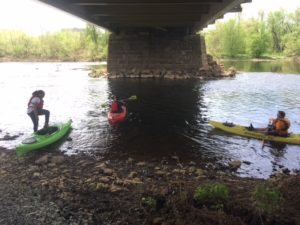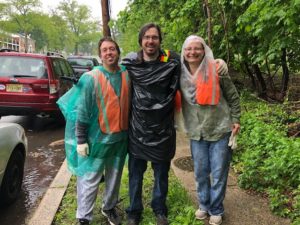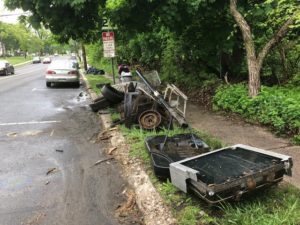Article by LRWP intern Allie Oross
During the May 21 LRWP meeting, attendees were treated by an insightful and comprehensive presentation on the importance of forage fish and their essential role in a functioning ecosystem. Presenting this information was Zack Greenberg, a Senior Associate of The PEW Charitable Trusts. Zack explained the benefits of using a big picture approach to fishery management and elucidated the different regulatory acts that control the amount of fish being taken out of the water and endeavor to limit the complications of over-fishing.
Zack first provided an overview of The Magnuson-Stevens Act (MSA), the primary law that governs the management of marine fisheries and is responsible for the rebuilding of 43 previously over-fished populations since 2000. Though this law continues to be a significant step towards sustainable management practices, it is constantly targeted by politicians attempting to weaken the guidelines that limit over-fishing and the punitive measures taken when someone violates these guidelines. While the goal of the MSA is to prevent over-fishing while achieving optimum yield, it focuses on individual species and treats their population numbers as mutually exclusive from each other. On the other hand, Ecosystem-based Fisheries Management (EBFM) seeks to remediate this oversight by looking at the different marine species as interlocked pieces in the puzzle that is marine conservation. EBFM seeks to protect the deceptively insignificant forage fish that are actually the foundations for a thriving aquatic habitat. Forage fish include species like salmon, trout, herring, shad, alewives, menhaden, and so on.
By monitoring the fluctuations in population size for different marine species and establishing balance between the different trophic levels in the ocean, a big picture approach emphasizes the interspecies connections that make up an ecosystem. Though these forage fish are small and have little direct market value on their own, they provide an invaluable food source for many of the larger marine species. Removing this resource could have negative implications, not only on the environment, but also on the economy. Taking away the fish that provide nourishment for larger sea life (like marine mammals, sportfish, sharks, seabirds, etc.) can influence recreational activities and the businesses that rely on them. Innumerable coastal and riverine communities (including communities on the Raritan River and Raritan Bay) would lose tourism if they couldn’t provide visitors with opportunities such as fishing, boating, whale watching, and/or diving. The protection of these forage fish is not currently covered under the MSA, which leaves them very vulnerable.
Marine and freshwater ecosystems are connected by much more than just the water that flows between them. Multiple forage fish species, including alewives and herring, are anadromous, meaning they migrate from the sea to freshwater rivers in order to spawn. These same species are also suffering from radically low populations due to marine bycatch, which prevents adults from ever reaching their spawning destinations and successfully propagating the species (Hasselman et al, 2016). Along with the obstacle of bycatch, river damming also frequently impedes many fish from migrating upriver to spawn. Many river-focused attempts at repopulating forage fish species have been relatively unsuccessful due to the marine based causes of population decline (bycatch, over-fishing, habitat degradation, etc.) (West, 2017). With improved federal fishery management and strengthened marine conservation policies we can negate the damage we have inflicted not only on individual species but on the environment as a whole.
The Pew Charitable Trusts, the LRWP and other environmental groups that understand the tremendous value of the “small fish” encourage the public to stand up on the issue of declining forage fish populations. The public has until June 25 at 5 PM to provide comment to the New England Fishery Management Council on a “control rule” for Atlantic Herring fishing in New England. Pew is rallying signatures/letters in support of the Council creating a 50-mile coastal buffer from herring trawling and implementing a science-based control rule. Please consider signing Pew’s Action Alert, or send an email to the New England Fisheries Management Council to let them know that you care about New England’s coastal ecosystem and economy, and that you want them to extend a buffer zone to 50 miles offshore year-round in which midwater trawl fishing would not be allowed to operate.
Referenced Articles
- Hasselman, D. J., Anderson, E. C., Argo, E. E., Bethoney, N. D., Gephard, S. R., Post, D. M., Palkovacs, E. P. (2016). Genetic stock composition of marine bycatch reveals disproportional impacts on depleted river herring genetic stocks. Canadian Journal of Fisheries and Aquatic Sciences, 73(6), 951-963. doi:10.1139/cjfas-2015-0402
- West, A. (2017-2018). Forcing Evolution’s Hand. Inquiry Magazine, 29-32. https://officeofresearch.ucsc.edu/ord/outreach/inquiry.html
Thank you volunteers!!
It was a gloomy, rainy Saturday, but on May 12, more than 150 people joined the Lower Raritan Watershed Partnership, Greater Brunswick Charter School, Esperanza Neighborhood Partnership, Friends of Mile Run Brook and Elmwood Cemetery for a multi-site community clean-up and celebration of New Brunswick’s Mile Run Brook.
Friends of Mile Run Brook
The clean-up was enlivened by our roving “Trash Troubadour” – Dave Seamon – who engaged our volunteers with song and stories as they cleaned-up the stream. Our Trash Troubadour traveled with a large sculptural bread-and-puppets style bottle (made from trash found during prior clean-ups) that clean-up volunteers covered with messages of environmental hope.

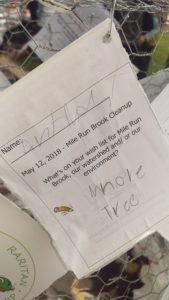
The clean-up was followed by a free community celebration and picnic in New Brunswick’s Boyd Park – with delicious contributions of dishes donated by Panico’s Brick Oven Pizza, La Poncena, Harvest Moon, Pizza Mia and Popeye’s Louisiana Kitchen.
At the end of the clean-up we joined together for a picnic and celebration, the Trash Troubadour created and performed a new song from the messages received.
Filmmaker Jessica Dotson is working on a music video story of the day – a gift for our Mile Run Brook and New Brunswick Community. But for now, click on the photo of our Trash Troubadour to enjoy a youtube video of his riverside performance:
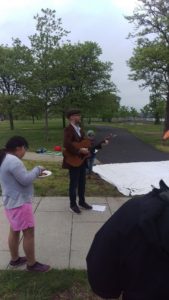
With tremendous thanks to New Brunswick Department of Public Works, North Brunswick Department of Public Works and Rob Hughes, our Americorps Watershed Ambassador for helping with planning, coordination, supplies provision and arranging for disposal of the trash and recycling. Thanks also to the Highland Park Ecology and Environmental Group and Central Jersey Stream Team for bringing your muscle to the clean-up for the day!
Trash Collected at the Hamilton Street Site
Esperanza Neighborhood Project Volunteers!!
The Elmwood Cemetery volunteers (coordinated by the New Brunswick Environmental Commission), removed 14 bags of trash and 6 bags of recycling.
The Greater Brunswick Charter School removed approximately 1,275 pounds of trash and 720 pounds of recycling.
The Esperanza Group removed an estimated 875 pounds of trash and 390 pounds of recycling.
The Friends of the Mile Run removed about 400 pounds of trash and 210 pounds of recycling.
In addition, 20 bulk items and 6 tires were removed as well.
Collectively volunteers removed approximately 2 tons of litter and bulk items from Mile Run Brook!
THANK YOU!!
Article and photos by Joe Mish
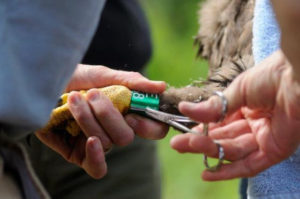
Rose gets a green aluminum band affixed to her left leg and a silver band to her right leg. Green is the band color used by NJ and silver is a federal band. Each state uses a specific color to quickly identify a banded eagle’s origin.
Over last century as the northeast bald eagle population dwindled, their image flourished as a marketing tool to brand high end merchandise. Gilded eagles sat upon flag poles in parades and auditoriums. Dollar bills and quarters bore engraved, lone eagles, wings spread and talons flared, about to attack at the least provocation.
Never did any image show more than one eagle, even though they mate for life and are dedicated parents. As a generation, we came to know eagles as powerful solitary creatures frozen in iconic poses. There was nothing to challenge that image, the skies were empty and no shadows could be seen speeding across the land. Least of all in central NJ, a land reputed to be sanitized of nature.
Awareness of man’s place in the natural world and his impact on the environment began to be studied in universities like Rutgers College of Agriculture and Environmental Science in the late 1960s, which opened the door to a new era of enlightenment and activism. Books like Silent Spring and Sand County Almanac were the seeds sown to nourish the idea humans were not apart from the cascade of life that flowed, uninterrupted, from the soil and water to apex predators, like the eagle and peregrine falcon.
Eagle restoration in NJ began in earnest in the 1980s accompanied by an ever-growing accumulation of study data gleaned by observation and scientific research. Still the view of intimate eagle relationships and social interaction remained at a sky-high level and not well published for public consumption.
Eagles kept their privacy and legacy reputation as solitary creatures intact until the advent of live cameras, genetic mapping, banding and miniature transmitters.
As far as the public is concerned, it is the live cams, set above some nests and broadcast on the internet, that provide non-stop coverage of eagle antics in the aerie to feed an insatiable voyeuristic human appetite.
The forums that accompany these spy cams generate lively conversation and together, have created a whole new audience beyond those immersed in all things nature. People who can’t tell a snow goose from a snow bunting, are now addicted a wildlife reality show.
And addictive it is, as viewers and scientists both learn what goes on behind nest walls. As voyeurs watch, they see behaviors that mimic human responses. The eagle screaming at its partner could very well be a replay of last night’s argument with their spouse, “who never listens to a word I say”.
Cumulatively, what we see are personality differences among pairs of eagles, where before we had only anecdotal observations and generalized conclusions. We knew the eagle as a solitary warrior and now we see a great raptor dedicated to its mate and offspring. When we look closely into the world of an eagle we see a glimpse of ourselves.
Locally the intrigue has been riveting, with a ringside seat to a female ingénue coming between a mated pair, a harassing hawk obliterated by an annoyed eagle and tender moments of dedicated parents doting on their precious offspring.
We watch as courting behavior evolves into mating, egg laying and alternate job sharing, as pairs relieve each other from brooding duty. We see and hear the wailing of one parent when their mate fails to return, either through injury or death. You cannot be unaffected by that sight and sound as what you experience is automatically translated into human terms.
A live cam from another state showed a female eagle covering her three, day old chicks, as a late spring snowstorm raged. That moment was tender enough but then the male positioned himself alongside the female, resting his head on her shoulder and spread his wings to shield his mate and their chicks from the heavy snowfall; our collective tears flowed.
Recently an eagle that prematurely fell from a local nest was rescued, examined and found to be in good health. Given that one parent went missing in the weeks prior to the fall and it was impossible to return the bird to the nest, a decision was made to place that eagle in another nearby nest.
Armed with the knowledge of intimate eagle behavior and demonstrated dedication to their young, fostering that young eagle was done with full confidence it would be accepted and thrive.
Only time will tell but so far, so good. Years hence, if you see a bald eagle bearing a green leg band, engraved with E68, you now know the rest of the story. Consider an eagle that was killed, June 2015, in upstate NY by a car, was banded 38 years prior! So, eagle E68, affectionately named, Rose, and her foster siblings, E66 and E67 have a good chance to be seen by your grandchildren!
Author Joe Mish has been running wild in New Jersey since childhood when he found ways to escape his mother’s watchful eyes. He continues to trek the swamps, rivers and thickets seeking to share, with the residents and visitors, all of the state’s natural beauty hidden within full view. To read more of his writing and view more of his gorgeous photographs visit Winter Bear Rising, his wordpress blog. Joe’s series “Nature on the Raritan, Hidden in Plain View” runs monthly as part of the LRWP “Voices of the Watershed” series. Writing and photos used with permission from the author.
Article and photos by Joe Mish
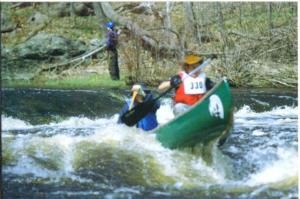
The powerful watery hand of the river reaches up in a wild mood to toss its dance partner skyward.
A canoeist might think of the river as a dance partner whose energy flow and mood sets the tone for the style of dance to be performed. A waltz, a tango or lambada are all on the river’s dance card to be enjoyed or sat out. Any paddler who wishes to partner with the river and enjoy the wide variety of watery tunes must have practiced moves, familiarity with boat and paddle and an ability to read the subtle nuance of wave patterns reflecting the structure of the hidden riverbed.
While high water and low water dances may be thoroughly enjoyed, I originally coined the term ‘river dance’ to describe the convoluted navigation required to follow the low water flow typically occurring on the South Branch during the summer.
Each year, winter ice and downed trees reshape the river bed to form new shoals, islands and channels which leave the scars and wrinkles that figure so prominently when water levels drop in the summer.
Low water and limited paddler skill do not preclude a float trip down the river as a grounded boat may be dragged across exposed shoals and shallows to deeper water.
Plodding along does not equate to river dancing but it gets the job done.
The joy of river dancing comes into play when the paddler, perhaps in a solo canoe, seeks out cuts and channels that hold just enough water to support the boat. Following the deepest water when the riverbed becomes a player in the band may mean tracing a convoluted course from one side of the river to the other. This shallow water navigation strategy is directly applicable to high, fast water flowing through boulder strewn stretches of river. Both situations require reading the wave patterns to determine the best path beyond the next immediate move.
One fast water section where I launch always has sufficient water from bank to bank for about a hundred yards. During lower water levels the left side and most of the middle of the riverbed is almost exposed and not navigable except for a narrow cut quite close to river right. As is often the case, a direct downstream approach to the deep water cut is not possible because the water directly above the cut is too shallow or has a downed tree blocking that approach. As the situation and solution is obvious from a long distance upstream there is time to gradually approach the passage at a forty-five degree angle and then straighten the boat with a quick draw to follow perfectly in the strong deep current.
Further downstream near a bend in the river, a long treeless island appears, the right side of which is navigable in a channel that runs along the opposite bank. As the channel nears the end of the island, it flattens out and disappears. The water then seeks to run at an angle across the raised center section of the riverbed. The riverbed here appears to have a profile of a typical crowned roadway and the main channel reappears to run just along the tip of the island. Crossing the riverbed from one channel to the other requires a good look at the wave patterns. If you know nothing, then just observe the differences in the wave patterns. In very shallow water they are almost indistinguishable but with practice differences will become apparent. Generally, flatter waves reflect deeper water. Or simply put, the less busy the surface of the water appears, the further above the riverbed it is. Don’t be surprised sometimes to find the water too shallow despite choosing the most favorable pathway. Crossing an ultra shallow channel as described, may require the paddler to shift their weight forward to create an absolute neutral balance in the boat to avoid a fore or aft drag. Shifting paddler weight to one side in a typical shallow V-shaped hull will often decrease the depth the hull protrudes into the water and might make the difference between stepping out and dragging the boat or barely floating by with some slight scraping.
One of the most useful skills a paddler can acquire is the ability to ferry. A ferry is a method which allows cross stream travel in swift water with minimal paddler effort.
I usually stop to do a ferry whenever fast water presents itself just because it is so much fun and feels like magic. A ferry is based on the premise that a canoe becomes invisible to the current when perfectly aligned with the water flow. A canoe can be paddled upstream and held in position without any downstream travel when the hull is parallel to the water flow. Eventually when the hull begins to angle across the current the boat will be washed downstream. The speed with which the boat is carried downstream depends on the angle of the boat to the water flow. The greater the hull angle, the greater the surface area the current has to push against. A ferry is possible when the boat is angled into the current and that angle held steady by the paddler. Very fast water requires a shallow angle to be held, the slower the water speed the greater the angle needed to perform a ferry.
Often the current speed changes as you cross the river and the boat’s position must be adjusted appropriately. The magic occurs when you realize the boat, held at the proper angle, begins to cross the current from one side to the other without any downstream travel!
A ferry can be accomplished with the bow upstream or downstream. Simply angle the upstream end of the boat in the direction of the shore you wish to reach. In very fast water you might suddenly find yourself at the precipice of a ledge with no chance of safe passage. Not to worry. Straighten the hull with any and all paddle strokes that might be applicable, hold the boat steady. Choose your angle and be amazed as your boat becomes a magic carpet to drift you above the ledge, perpendicular to the current, and on to a safe passage or convenient eddy.
Do not despair when summer water levels fall and most folks abandon the thought of paddling the local rivers. Armed with patience and agility you might try to dance with the river on her terms.
Author Joe Mish has been running wild in New Jersey since childhood when he found ways to escape his mother’s watchful eyes. He continues to trek the swamps, rivers and thickets seeking to share, with the residents and visitors, all of the state’s natural beauty hidden within full view. To read more of his writing and view more of his gorgeous photographs visit Winter Bear Rising, his wordpress blog. Joe’s series “Nature on the Raritan, Hidden in Plain View” runs monthly as part of the LRWP “Voices of the Watershed” series. Writing and photos used with permission from the author.
On Saturday May 5 several partners helped the Borough of Bound Brook inaugurate its first kayak/canoe launch site. A partnership between the Borough and New Jersey American Water (NJAW) resulted in an access agreement to allow recreational use of private land, giving paddlers a new access point to the Raritan River. The agreement between the Borough and NJAW allows the public to put their watercraft into the Raritan in an area owned by NJAW under the Queens Bridge in the Borough.
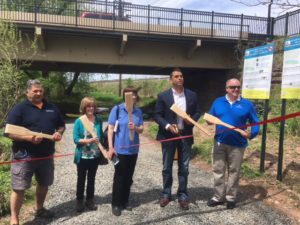
Bound Brook Borough Administrator Hector Herrera and Council President Abel Gomez were joined by representatives of South Bound Brook; Somerset County; New Jersey American Water; Pfizer on behalf of Wyeth Holdings; the Raritan Riverkeeper; National Park Service Rivers, Trails & Conservation Assistance; and members of the public for the ribbon cutting and launch ceremony on a beautiful spring day. Signs explaining how to use the access site with a map of downtown Bound Brook greeted launch users in English and Spanish.
Council President Abel Gomez noted: “This launch site for kayaks and canoes is part of a bigger plan to restore public access to the Raritan River. In 2015, the Borough’s Economic Development Advisory Committee published Riverfront Access Plan for Pedestrians and Bicyclists. This plan puts forth strategy and initiatives for a comprehensive bicycle and pedestrian network to connect downtown commercial areas with the riverfront. The launch site is another element that makes Bound Brook a destination area.”
In addition to the access to the River for paddlers, the Plan calls for the creation of a park along the waterfront from Queens Bridge to Middle Brook, including the development of a riverfront trail system for pedestrians and bicyclists using inactive rail corridor and a levee system. Raritan Riverkeeper Bill Schultz explained that the “launch site will mean that paddlers can now travel all the way from Bound Brook downstream to Perth Amboy and the Raritan Bay, about 18 miles. Raritan River recreation complements the land-based recreation currently available on the south side of the river, as part of the Delaware & Raritan Canal State Park.”
The Borough is receiving technical assistance from the National Park Service’s Rivers, Trails & Conservation Assistance Program. The NPS helped form a steering committee made of local stakeholders, including New Jersey American Water, Somerset County Planning Division, Rutgers University Edward J. Bloustein School of Planning and Public Policy, Pfizer on behalf of Wyeth Holdings, and members of the Bough’s Economic Development Advisory Committee.
The Riverfront Access Plan is available at: http://boundbrooknj.org/MasterPlan/RiverAccessPlan
For more information about the project, contact Bound Brook Borough Administrator
Hector Herrera at 732-893-8520 or hherrera@boundbrook-nj.org
